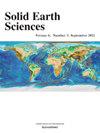利用GALDIT模型评估孟加拉国西南沿海地区含水层对海水入侵的脆弱性和土地利用变化的影响
IF 2
4区 地球科学
Q3 GEOSCIENCES, MULTIDISCIPLINARY
引用次数: 0
摘要
在孟加拉国西南沿海地区,由于海拔低、靠近海洋、气旋、海平面上升、沿海洪水和过度养殖虾类,地下水作为沿海人口的主要饮用水源正日益受到海水入侵的威胁。本研究的目的是评估孟加拉国西南沿海地区地下水脆弱性,并评估土地利用变化对海水入侵的影响。本研究利用GALDIT方法绘制了西南沿海含水层的海水入侵脆弱性图,将其划分为低(0.5%)、中(58.66%)和高(40.84%)3个脆弱性区。GALDIT脆弱性图显示,Satkhira地区的Shyamnagar、Kaliganj和Satkhira Sadar对海水入侵的脆弱性较高,其他地区为中等脆弱性。在库尔纳地区,大多数乌帕齐拉人处于中等脆弱状态。在Bagerhat地区,大多数Upazilas被列为中度脆弱,而Sarankhola、Mongla和Morrelganj被确定为高度脆弱。最广泛的灌溉发展是在Satkhira地区,特别是在Satkhira Sadar、Kolaroa、Assasuni和Tala等中等脆弱地区。库尔纳地区的Dumuria村由于灌溉用水过度而非常脆弱。在巴格哈特地区,法基哈特和莫拉哈特最近扩大了灌溉,这两个地区都处于中等易感区。LULC分析显示,农业和植被区域减少,建筑密集区和虾类养殖区增加,主要表明研究区域的盐度水平增加。在整个研究区域,咸淡水虾养殖占主导地位,这表明浅层地下水含水层可能面临海水入侵的风险。本文章由计算机程序翻译,如有差异,请以英文原文为准。

Assessing aquifer vulnerability to seawater intrusion and impact of land use changes using GALDIT model in the southwest coastal region of Bangladesh
Groundwater, the main drinking water source for coastal populations, is increasingly threatened by seawater intrusion in southwestern coastal districts of Bangladesh due to low elevation, sea proximity, cyclones, rising sea levels, coastal flooding and excessive shrimp farming. The aim of this study is to assess groundwater vulnerability in Bangladesh's southwestern coastal districts and evaluate the impact of land use changes on seawater intrusion. This study used the GALDIT method to map the vulnerability of southwest coastal aquifers to seawater intrusion, classifying the area into low (0.5 %), moderate (58.66 %), and high (40.84 %) vulnerability zones. The GALDIT vulnerability map shows that Shyamnagar, Kaliganj, and Satkhira Sadar in Satkhira district are highly vulnerable to seawater intrusion, while the other areas are moderately vulnerable. In Khulna district, most of the Upazilas are moderately vulnerable. In Bagerhat district, most of the Upazilas are classified as moderately vulnerable, while Sarankhola, Mongla and Morrelganj are identified as highly vulnerable. The most extensive irrigation development was observed in Satkhira district, particularly in Satkhira Sadar, Kolaroa, Assasuni, and Tala upazilas, classified as moderately vulnerable. The Dumuria upazila of Khulna district is highly vulnerable due to overexploitation of water for irrigation purposes. In Bagerhat district, where irrigation has recently expanded in Fakirhat and Mollahat, both are in the intermediate susceptibility zone. The LULC analysis shows a decline in agricultural and vegetative areas, alongside a rise in built-up regions and shrimp farming, primarily indicating the increasing of salinity levels in the study area. The dominance of brackish water shrimp farming across the study area suggests shallow groundwater aquifers may be at risk of seawater intrusion.
求助全文
通过发布文献求助,成功后即可免费获取论文全文。
去求助
来源期刊

Solid Earth Sciences
GEOSCIENCES, MULTIDISCIPLINARY-
CiteScore
3.60
自引率
5.00%
发文量
20
审稿时长
103 days
 求助内容:
求助内容: 应助结果提醒方式:
应助结果提醒方式:


